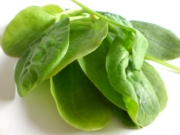นมสด โดยเฉพาะนมแพะ แกะ
Milk is particularly sensitive to the effects of a radioactive fallout
Raw milk is one of the foods that are most likely to become contaminated by radioactive iodine as livestock feeds on grass which is particularly prone to radioactive contamination during nuclear disasters. Goat's milk and sheep's milk appear to be particularly sensitive to contamination as goats and sheep feed on plants that have a low water (are more concentrated). Goat's milk and sheep's milk have been reported to contain approximately 10 times the concentration of radioiodine found in cow's milk.
The contaminated milk was found in Fukushima Prefecture on farms about 20 miles from the damaged nuclear reactors. Japanese food safety and health officials reported that the iodine-131 (I-131) found in the tested milk was up to five times the level the government considers safe.
ผักขม, ตั้งโอ๋, ผักกาดหอม และ Leeks
Spinach and other leafy vegetables and herbs can directly capture radioactive substances from the air. Cabbage and other leafy vegetables that do not have leaves spread out may be less likely to collect large amounts of particles from the air.
The radioactive spinach in Japan was found in Ibaraki Prefecture on farms 60 to 90 miles from the ravaged nuclear power plants. The level of radioactivity found in the tainted spinach, if consumed for one year, would equal about one-fifth of radiation received in a CT scan (a CT scan is a compressed series of X-rays used for medical tests). Also garland chrysanthemum in Chiba Prefecture has been found to contain elevated levels of iodine 131.
Mushrooms
As of March 21, 2011, Japanese health and food safety officials have reported abnormal levels of radioactive substances in milk, spinach and garland chrysanthemum (and slightly elevated levels in drinking water in some areas). However, there are a number of other foods that are particularly prone to becoming affected by radioactive substances released by faulty nuclear power plants. Wild Mushrooms, which use absorption to obtain nutrition from the atmosphere, are prone to accumulating radioactive substances such as cesium-134 (134 Cs), cesium-137 (137 Cs) and other radionuclides. Cesium-134 has a half-life of approximately 2 years, while cesium-137 has a half-life of 30 years! Radiocesium can damage human DNA and ultimately result in cancer.
Berries
bilberries, cranberries, cloudberries, blackberries and wild strawberries. As the half-life of cesium-137 is 30 years, berries contaminated by this radioactive substance are still found in certain regions in Europe. However, in most cases, the level of radioactivity detected is very low.
อันนี้ไม่ได้กล่าวถึงกุ้งหอยปูปลาเท่าไหร่ แต่ถ้าดูคอนเซปท์แล้ว สาหร่ายทะเลก็ท่าทางจะโดน
Seaweed from the coast of Japan – brown macroalgae in particular – could present a concern, according to Dr. Fisher. He explains that it takes up iodine at a level that is 10,000 times more concentrated than it is in sea water. This seaweed is harvested mostly to extract alginate, which is an additive used in products like toothpaste and ice cream.












ไม่มีความคิดเห็น:
แสดงความคิดเห็น